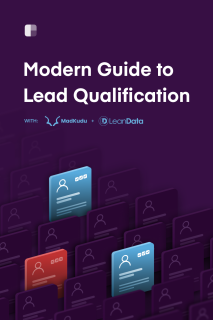Chapter 1
5 minutes
Introduction
Sometimes, things turn out perfectly when you just follow the rules and go by the book.
Lead qualification, however, is not one of those things.
You can read everything that SaaS companies are "supposed" to do, and set up the theoretically perfect system, but still get poor results. Why? Because context is everything, and your setup needs to match your company’s goals and stage of growth.
A too-complex system takes a lot to maintain, and it might burn your resources without providing enough value. You can get far with a simple lead scoring model. On the flip side, a too-simple model can hold you back as you scale.
At Clearbit, we learned this lesson firsthand. For example, our brilliant analytics team developed an advanced intent-based scoring model. We did everything "right," investing in a tech stack that was custom-built for our marketing team, and it was a beautiful beast to behold. But once it launched, we realized our lead volume wasn’t high enough for the model to be as useful as we’d hoped it’d be. At that point, we didn’t have the right marketing motions in place to support it yet. The advanced model was a little early and tech-heavy for our company maturity level.
Though we’re growing into the model, it taught us an important lesson: you can buy the most beautiful shoes, but they need to fit your feet.
You’ll get the most from your lead qualification system when its complexity matches your go-to-market strategy and your staffing. In this practitioner's guide to lead scoring and routing, we share maturity benchmarks and real-world advice to find that sweet-spot match for your own company.
What’s in this guide:
-
Quick glossary: Review definitions of common lead qualification terms below.
-
Lead scoring: Start with an overview of scoring concepts that are central to scaling up. Then, check business maturity benchmarks to help you find the right "size" of a lead scoring model for you. You’ll see examples of beginner, medium, and advanced scoring systems from real SaaS companies, and a discussion of how to actually implement scoring (What data and tools do you need? Should you build or buy your scoring tech stack?).
-
The human in the lead score: Time to get real. We talk about what it’s really like to do lead qualification at Clearbit, our lessons learned, and how we align marketing and sales around our automated scoring models. Then, see what’s worked and what hasn’t worked for marketing, ops, and sales practitioners from companies like LeanData, MadKudu, Census, and WordPress.com.
-
Routing and engagement after the score: Understand why exactly bad routing drives sales reps and leads up the wall, and check benchmarks to right-size your routing system. We also cover tools for routing and engagement, who should own routing, and how to fast-track and magic-ify your lead's experience with automated yet personalized systems.
We hope this guide helps you set up the perfect qualification system for your company’s stage of growth — and lay the groundwork for you to scale.

What is lead qualification?
Lead qualification is the process of determining whether a prospect fits your ideal customer profile (ICP), has a high chance of becoming a customer, and most importantly has a high chance of being a successful long-term customer.
Refer to the glossary below if you need to brush up on any terms while going through this book!
The ABCs of lead qualification
| Term | Definition |
| Lead qualification / lead scoring | Evaluating leads and sales opportunities to find the ones most likely to drive desired outcomes. MadKudu defines a lead score as "a quantification of the quality of a lead." |
| Lead routing | The process of assigning leads to sales (or customers to CS reps) in a way that uses sales resources efficiently and gives leads a prompt and positive experience. |
| ICP | Ideal Customer Profile: a representation of a customer who perfectly fits your business. A data-driven ICP is defined by concrete and quantifiable firmographic characteristics. |
| MQL | A Marketing Qualified Lead shows fit and some level of behavioral intent by engaging with your company and has the potential to become a customer. |
| SQL | A Sales Qualified Lead is even more likely to buy; they're ready to move into the sales process and talk to the sales team. |
| Accounts | An account is at the company level; a prospective or current customer. |
| Users | Users are people at that account who actively use your product. |
| Buyers | Buyers are the stakeholders at that account who make purchasing decisions about your product. They may or may not be users. |
| PLG | Product-led growth is a go-to-market strategy that relies on a product to acquire, activate, and retain users. |
| PQL | A Product Qualified Lead is a person who has experienced meaningful value using your product (ProductLed). |
| PQA | A Product Qualified Account is a company that has experienced value using your product at the organizational level. The account encompasses users and buyers. |
| Fit | A prospect's fit indicates how closely they match your ideal customer profile via identity characteristics like firmographics and any relevant persona details like job title. |
| Intent | Their intent is a measure of their displayed interest in purchasing a solution like yours. While fit indicates whether your company is interested in them, intent shows whether they're interested in you. |
| Sales + Marketing alignment | An ideal state in which sales and marketing are set up to support one another's goals or act as a multiplier for one another's efforts. They operate efficiently with shared workflows and create a seamless buying experience for prospects. |

